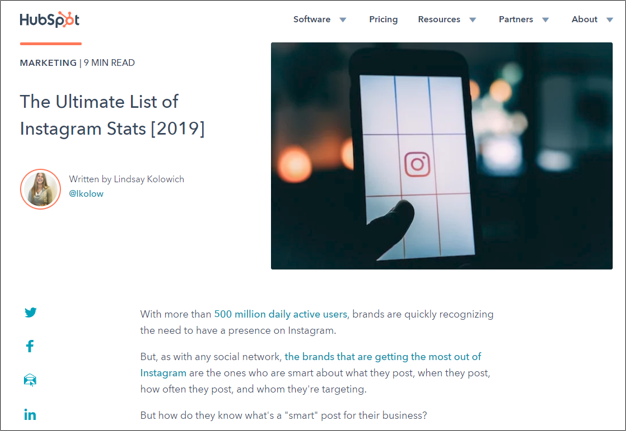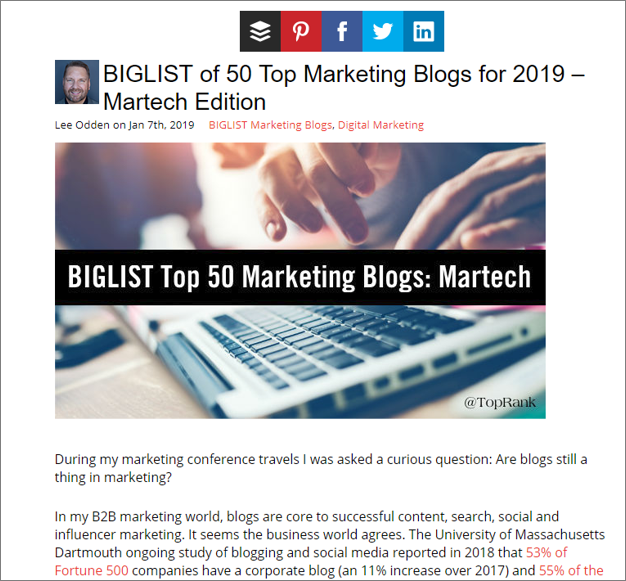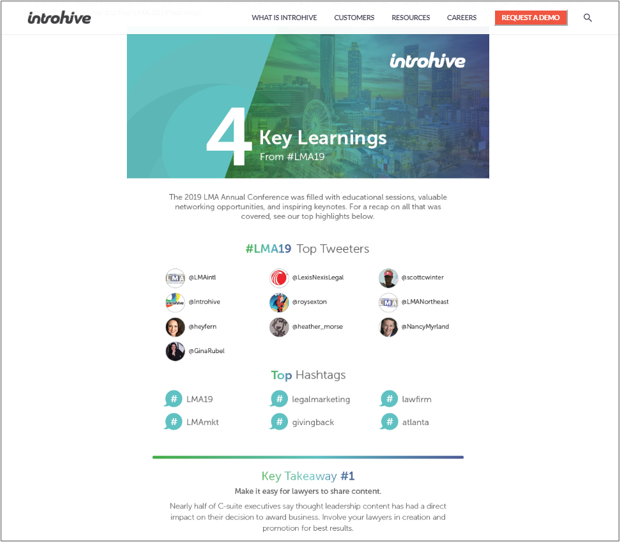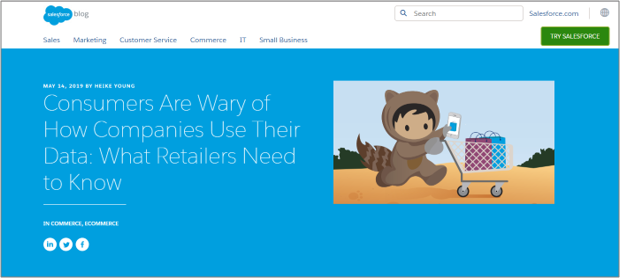Content Curation Inspiration: Types, Examples, & Use Cases for B2B Marketers

 If you create and share content, curation is part of your B2B marketing strategy. From seasoning a blog post with key third-party statistics to sharing an interesting article from an industry publication or influencer across your social channels, you’re curating. But content curation has a place beyond adding an insight or two to your content. With large volumes of information available today and short attention spans, curation allows content marketers to create more convenient, valuable content experiences for their target audience, while growing thought leadership, bolstering their content calendar, and increasing production efficiency. What types of curation exist? How are B2B brands doing curation? When does it make sense to do curation? Let’s dive in.
If you create and share content, curation is part of your B2B marketing strategy. From seasoning a blog post with key third-party statistics to sharing an interesting article from an industry publication or influencer across your social channels, you’re curating. But content curation has a place beyond adding an insight or two to your content. With large volumes of information available today and short attention spans, curation allows content marketers to create more convenient, valuable content experiences for their target audience, while growing thought leadership, bolstering their content calendar, and increasing production efficiency. What types of curation exist? How are B2B brands doing curation? When does it make sense to do curation? Let’s dive in.
Types of Content Curation and B2B Examples
The Curation Kitchen Staples: Microcontent
Statistics. Quotes. Tips. Social media commentary. Third-party videos. Gifs. Memes. Curated microcontent is what gives your content its flavor—whether its used as seasoning in a long-form blog post or modularly in short-form social content. This is foundational curation, and it plays a role in all other types. And as TopRank Marketing CEO Lee Odden once said:“Snackable content can often be managed and repurposed like ingredients to create a main course. On their own, short-form content like quotes, tips, and statistics are useful for social network shares and as added credibility to blog posts, eBooks, and articles.”See what I did there? Microcontent is simplistic and easy to integrate, helping you provide more depth and insight on a topic, infuse credibility, and highlight industry experts. When microcontent curation makes sense: Always—if the content is relevant to the topic you’re discussing. Microcontent helps you provide proof points to bolster your narrative and build credibility with your audience.
The Curation Classics: Roundups, Listicles, and Resource Hubs
Collecting key bits of information and insights and organizing them into an easy to digest format is the quintessential content curation tactic. The premise is simple: You’re gathering interesting tidbits from multiple sources on a specific topic and placing them in one central location. The underlying theme for this curation tactic (and any content tactic for that matter) is relevance and value. It needs to be topically relevant to your audience and it can’t be a lazy compilation; it needs to serve a purpose. News roundups are perhaps the most popular of the curation classics. We’ve all seen them and likely have a few we go back to on a regular basis, so I won’t spend too much time here. (Shameless plug to check out our weekly digital marketing news roundup.) But here’s an example of a roundup style piece from EHS and sustainability consulting firm *Antea Group that brings video content together to have a little fun and spark a connection with the audience. The post showcases six workplace safety videos—all sourced and easily embedded from YouTube—with movie-critic-like commentary that make connections to the daily life and work of their target audience. When it comes to resource hubs, HubSpot is an “ultimate list” destination on a variety of subjects, most notably digital marketing statistics. Here’s a recent example featuring Instagram statistics.
When it comes to resource hubs, HubSpot is an “ultimate list” destination on a variety of subjects, most notably digital marketing statistics. Here’s a recent example featuring Instagram statistics.  For listicles, one of our recent BIGLIST editions featuring 50 of the top marketing blogs featuring martech brands is a solid example. Time was spent on researching and vetting, and the list provides a short and sweet description of each blog, as well as our favorite recent article to give readers a cue on what’s worth checking out first.
For listicles, one of our recent BIGLIST editions featuring 50 of the top marketing blogs featuring martech brands is a solid example. Time was spent on researching and vetting, and the list provides a short and sweet description of each blog, as well as our favorite recent article to give readers a cue on what’s worth checking out first.  Finally, events can be great opportunities for curation. *Introhive, an enterprise relationship management (ERM) platform, regularly curates social and team member insights to compile post-event infographics with top takeaways.
Finally, events can be great opportunities for curation. *Introhive, an enterprise relationship management (ERM) platform, regularly curates social and team member insights to compile post-event infographics with top takeaways.  When classic curation makes sense: Classic curation is largely an awareness and engagement play. If you’re looking to provide your audience with a helpful resource that hits quick on the points, and showcase your brand as a thoughtful expert in the space, this type of curation can make it easy for your audience to find insight and inspiration—and minimize the amount of time they need to spend on the hunt.
When classic curation makes sense: Classic curation is largely an awareness and engagement play. If you’re looking to provide your audience with a helpful resource that hits quick on the points, and showcase your brand as a thoughtful expert in the space, this type of curation can make it easy for your audience to find insight and inspiration—and minimize the amount of time they need to spend on the hunt.
The Next Level of Curation: Thought Leadership Mashups
Curation isn’t limited to assembling a robust, scannable list of information or resources, or seasoning original content with stats, quotes, or videos. Curation can fuel thought leadership. Great examples of this kind of curation are trends-focused pieces. Taking a cue from the classic curation formats, this kind of content aims to identify one or more trend or pattern using curated bits of information, all tied together with your knowledge and expertise. This could be small-scale or large-scale—meaning a single concept could provide the supporting content or tie-in, or it could be your take on a collection of related trends, facts, or insights. This piece from *SAP’s Digitalist Magazine is a great example. But this kind of curation doesn’t just lend itself to discussing trends. Many of our own blog posts use a mashup curation method to educate and engage marketers, and define our perspectives and approach to marketing. This can be seen in a recent post from Nick Nelson on how to write clear, concise content. Using our words intentionally is a core belief, and Nick was able to illustrate that with his deep knowledge and some relevant insights from third parties.
But this kind of curation doesn’t just lend itself to discussing trends. Many of our own blog posts use a mashup curation method to educate and engage marketers, and define our perspectives and approach to marketing. This can be seen in a recent post from Nick Nelson on how to write clear, concise content. Using our words intentionally is a core belief, and Nick was able to illustrate that with his deep knowledge and some relevant insights from third parties.  Also, when we say “curation,” we don’t just mean collecting insights from third-party sources. You can curate your own content—it’s just most often called repurposing. Salesforce has a great example here. This recent post touches on a key trend in the marketplace (lack of consumer trust), leverages microcontent from Salesforce’s own research (the Trends in Consumer Trust research report), and then original content builds a narrative for a specific audience (retailers).
Also, when we say “curation,” we don’t just mean collecting insights from third-party sources. You can curate your own content—it’s just most often called repurposing. Salesforce has a great example here. This recent post touches on a key trend in the marketplace (lack of consumer trust), leverages microcontent from Salesforce’s own research (the Trends in Consumer Trust research report), and then original content builds a narrative for a specific audience (retailers).  In addition, curating and repurposing influencer content is an especially big opportunity. More than likely, the insights that influencers share with you have implications and applications across other related topics. When curation mashups make sense: If you want to build thought leadership on a subject, mashups should be in your content lineup. Mashups allow you to elevate an idea, perspective, challenge, or opportunity, while using existing content as a jumping off-point or as part of the foundation of your take. Read: A Tasty, Strategic Addition to the Content Marketing Table: ‘Repurposed Content Cobbler’
In addition, curating and repurposing influencer content is an especially big opportunity. More than likely, the insights that influencers share with you have implications and applications across other related topics. When curation mashups make sense: If you want to build thought leadership on a subject, mashups should be in your content lineup. Mashups allow you to elevate an idea, perspective, challenge, or opportunity, while using existing content as a jumping off-point or as part of the foundation of your take. Read: A Tasty, Strategic Addition to the Content Marketing Table: ‘Repurposed Content Cobbler’
Content Curation for the Win
Regardless of your editorial plan, you’re already doing some form of content curation. However, you can make curation a more deliberate and effective part of your overall B2B content marketing strategy. Whether you create an ultimate list featuring statistics from multiple sources, provide high-level takeaways from an event or report, give your own content new life to build thought leadership, content curation can provide value and convenience for your audience and writing team. Looking for content curation best practices, tools, and more examples? Check out our post on Content Curation 101. *Disclosure: Antea Group, SAP, and Introhive are TopRank Marketing clients.The post Content Curation Inspiration: Types, Examples, & Use Cases for B2B Marketers appeared first on Online Marketing Blog - TopRank®.
Share from Online Marketing Blog – TopRank®
Content Curation Inspiration: Types, Examples, & Use Cases for B2B Marketers
 Reviewed by mimisabreena
on
Friday, May 17, 2019
Rating:
Reviewed by mimisabreena
on
Friday, May 17, 2019
Rating:
 Reviewed by mimisabreena
on
Friday, May 17, 2019
Rating:
Reviewed by mimisabreena
on
Friday, May 17, 2019
Rating:

















No comments:
Post a Comment